Blackness, Images & the Space Between
A conversation with Milwaukee based fine artist Nick Drain and Genesis Gallery owner, artist, and organizer Randy Brown. Nick recently held his first solo exhibition “In Plain Sight” at Genesis…
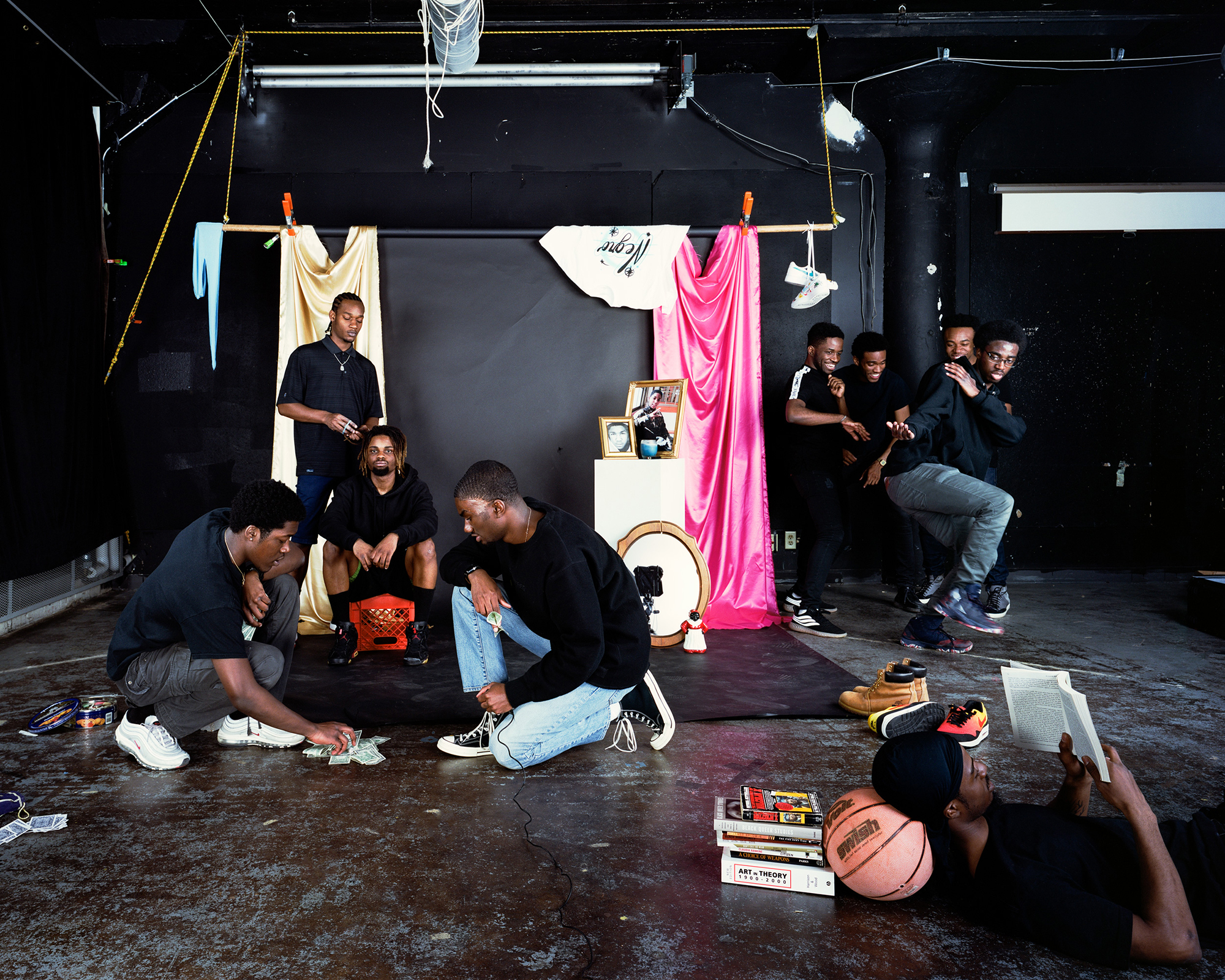
A conversation with Milwaukee based fine artist Nick Drain and Genesis Gallery owner, artist, and organizer Randy Brown. Nick recently held his first solo exhibition “In Plain Sight” at Genesis and our collective discussion quickly found its way circling around and through larger topics like race, identity, viewership and the politics of the Milwaukee art scene. Over the course of the last few months, I let our conversation sink in and settle where it needed to in order for me to get down to the guts of what the discussion meant for all of us.
I have a distinct memory of the moment I stood in front of Picasso’s “Guernica” at Museo Nacional Centro de Arte Reina Sofía in Madrid, Spain. It was the summer before college, I was only 18 years old and I didn’t think of myself as an artist then. I think back to that trip reflecting on the enormity and impact of viewing that painting in the flesh, and I realized it was a moment that hit me too early in life. I didn’t fully grasp how important and historical it was to be standing in front of such a powerful piece of art. The next time I had this profound artistic epiphany was in college, after I decided that I wanted to study art. The exhibition “30 Americans“ traveled to the Milwaukee Art Museum. The show (which continues to tour) features work from the Rubell Museum’s collection, and includes pieces from the most prominent contemporary Black artists from across the nation. It was the first time that I truly believed in the power of art – how it can move someone, say something important, stand for a cause. Of course, I believed art could do that, but this exhibition gave me a living, breathing example of it. At the time, I don’t think I fully realized how important it was for Milwaukee to have access to the artwork in “30 Americans.” Historically, Milwaukee has been known as one of the most segregated cities in the nation; where racial tensions have and still currently run high. The message of “30 Americans” is rooted in racial issues revolving around what it means to be a Black American in today’s world. The impact of “30 Americans” still rings true to this day and could arguably be considered more important now than ever.
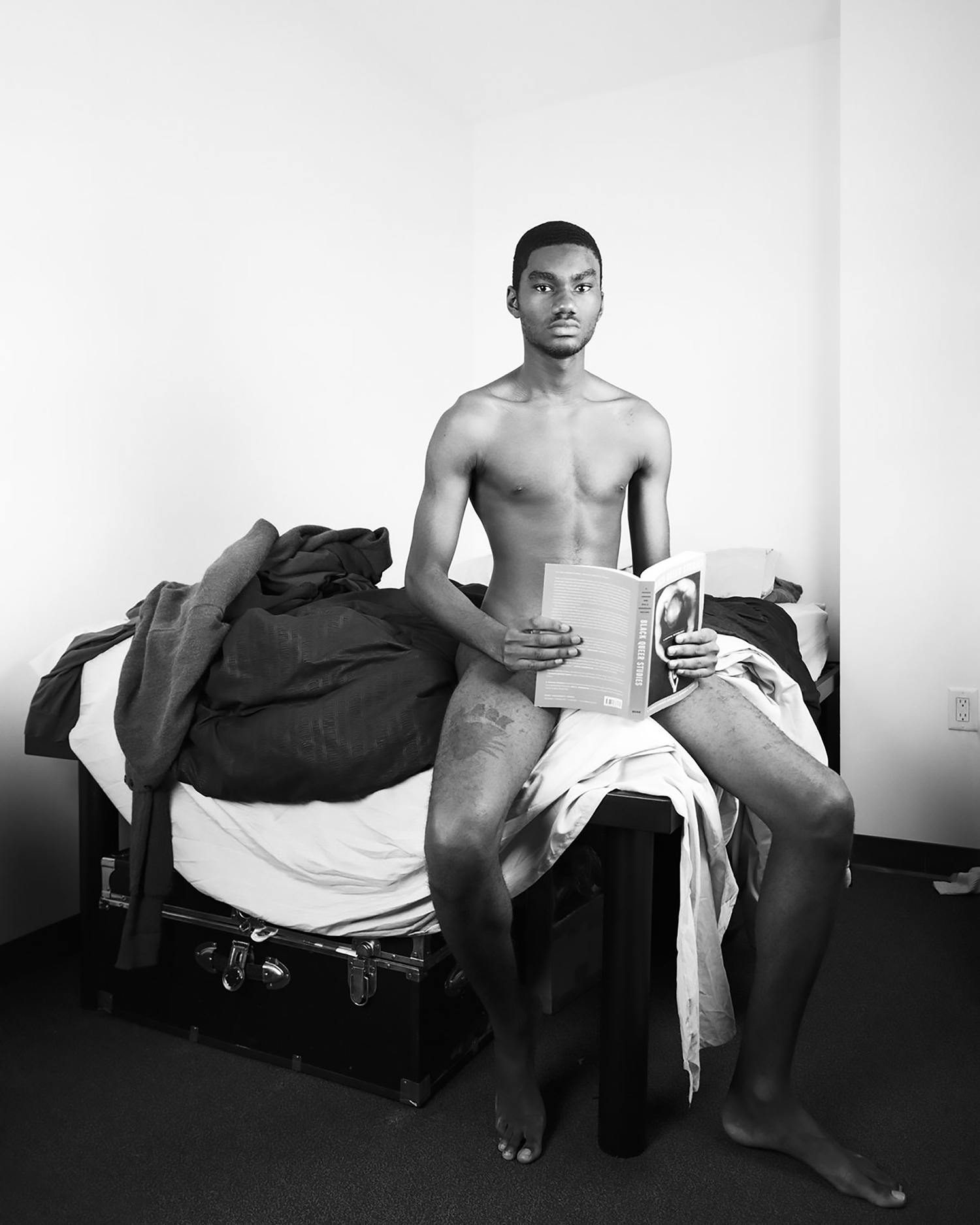
Image: Nick Drain “Black Queer Study” Archival Inkjet Print, 2019, Dimensions Variable. In the center of a black and white photograph, a black man sits nude on an unmade bed holding the book “Black Queer Studies: A Critical Anthology.” His gaze is directed at the camera while the book shields the viewer from his nakedness. Image courtesy of the artist.
Nick Drain is an artist living and working in Milwaukee. He attends the Milwaukee Institute of Art & Design (MIAD) and will receive a BFA in New Studio Practice this year. Nick’s first solo show “In Plain Sight” took place October 18, 2019 – December 13, 2019 and was the first exhibition at Genesis Gallery’s newest location in the Bayview neighborhood. As an artist who primarily works with images, Nick confronts the viewer with representations of Blackness through photographic self-portraiture, sculpture, and images. He explores ideas like the collective Black identity, visibility, and authorship vs. viewership in his work. Nick is interested in questioning the limits of photographic representation by investigating the functions of an image and exploring what images can or cannot contain. “In Plain Sight” consists of framed color and black and white photographs as well as sculpture. The group of images in Nick’s exhibition include self-portraits and staged photo-shoots with young, black male subjects. All of them confront the viewer with the notion of Blackness. His photograph, “One For Us” was created in an effort to answer Nick’s question: “Can I contain the whole of Black masculinity in one photograph? The answer is no. But what does it mean to try?” The image depicts nine young men, all black, and all wearing black clothing performing various actions. The scene isn’t framed perfectly, you can see it was intentional to include the structure of the photo backdrop, which has a shirt with the word “Negro” hung across it. Nick sits near the center of the frame, in profile, looking down at a stack of dollar bills across from another individual, as if playing a card game. He is holding the remote shutter release for the camera; making clear reference to the action of taking a photograph; the final piece being a product of the camera itself. The composition is filled with what could be deemed as “stereotypical Black objects” like multiple pairs of shoes and a basketball. Another figure in the photo is dancing, one reading with his head propped up on the basketball like a pillow. Nick’s attempt to answer his question about black masculinity was not futile; in fact “One For Us” became one of the most pivotal works in Nick’s practice, allowing him to begin to question the boundaries of an image. “There was a revolution in my thinking about images and about the camera…an interrogation, an inspection of the object of the camera itself. I’m thinking about images as a product of the camera and the things that images can and cannot contain,” reflects Nick. It feels that the image stands in as both a self-portrait for Nick, but is also representative of a collective identity – of Blackness.
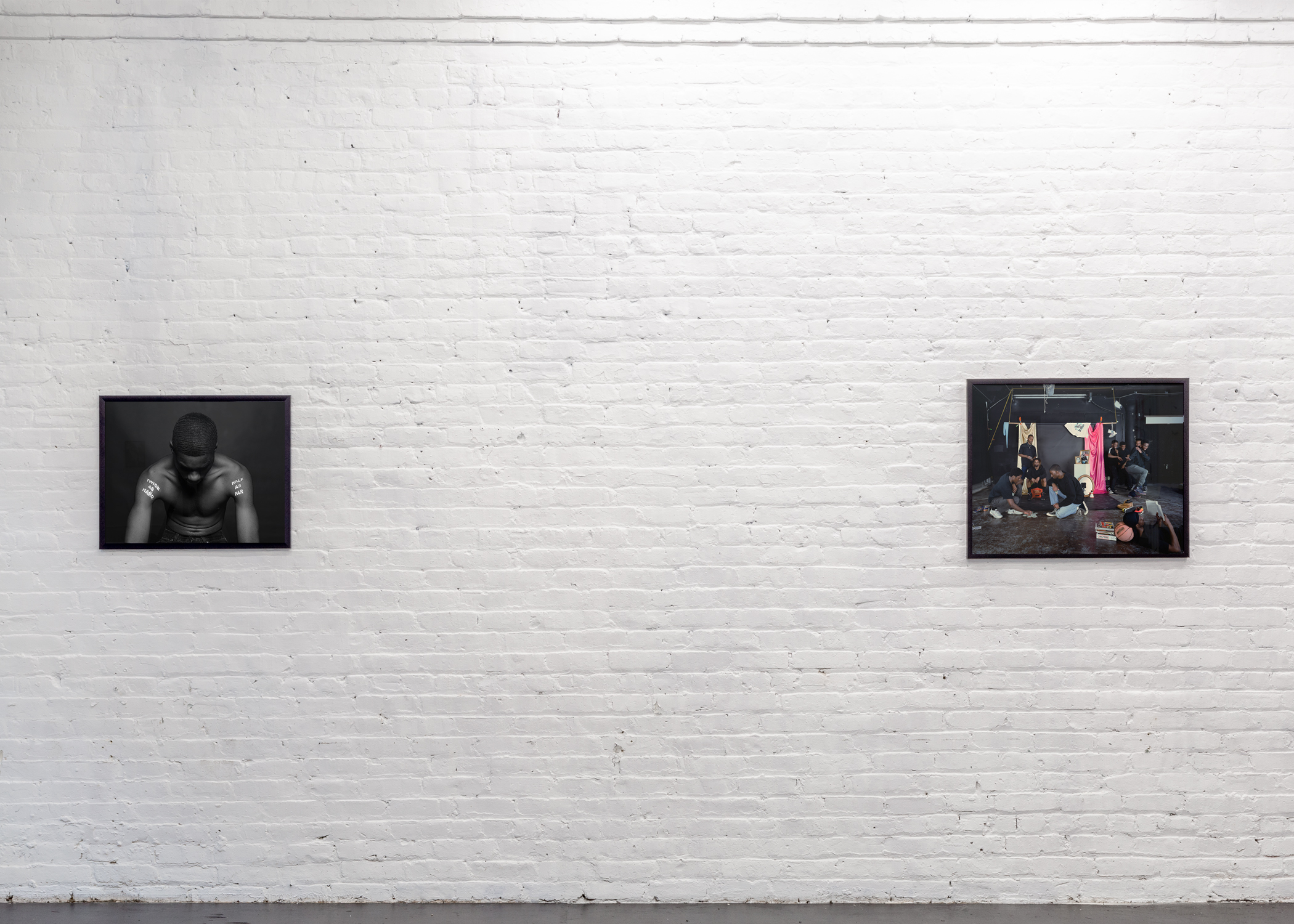
Image: Installation View of “In Plain Sight” at Genesis. Two framed photographs depicting black male figures hang on a white brick wall. The left photo is black and white and features one man hunched over looking down. The right photo is in color and features a group of people in various poses. Photo by Randy Brown. Image courtesy of Genesis.
“In everything I make, my experience is always one of being looked at. It’s like W.E.B Du Bois’ “double consciousness” – I am aware of myself as myself, but then I’m also aware of myself in relation to my Blackness and how it determines the conditions of my existence. They are not easily split apart. I’ve never had the privilege of just being able to be a representation of myself. So as someone who’s never gotten to think about myself NOT in relation to others, it’s the only way I know how to make work – to consider this “me” but then also who’s on the other side of it.” – Nick Drain
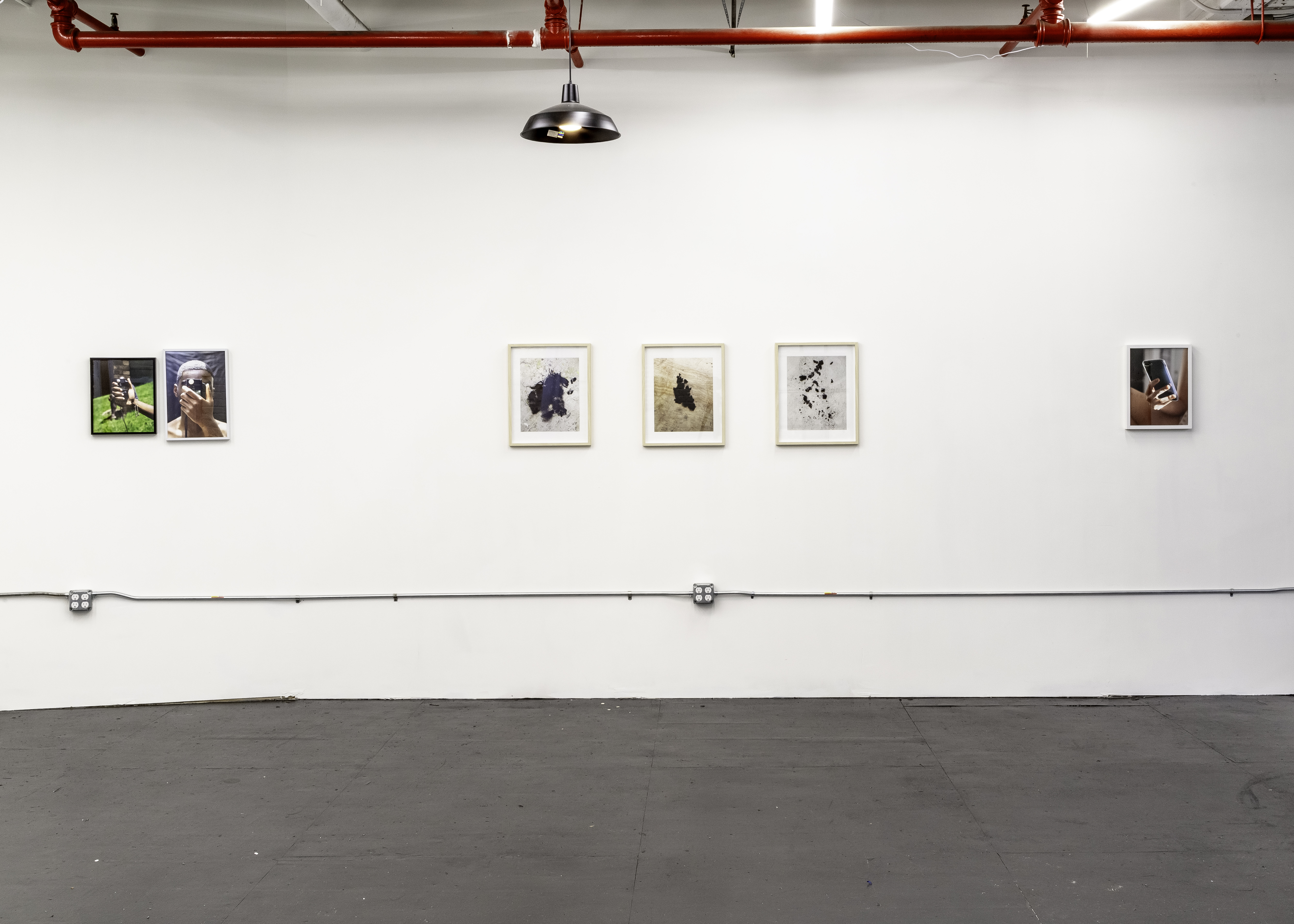
Image: Installation View of “In Plain Sight” at Genesis. A series of three framed photographs hang on a white wall in the center of the image. They are flanked by a group of two framed photographs (left) and one framed photograph (right). Photo by Randy Brown. Image courtesy of Genesis.
Milwaukee based artist Randy Brown first had a studio visit with Nick Drain in 2018. As the owner of Genesis, it didn’t take long for the artist to realize that Nick’s work aligned with the mission of the space. Nestled within a large complex of warehouses, near the Kinnickinnic River, Genesis is dedicated to creating an open and affirming environment for all artists. The space provides support and visibility for Milwaukee’s creative communities, and seeks to develop diverse networks of makers and thought leaders for a better, more inclusive Milwaukee. Since its inception, Genesis has worked with community organizations like the artist collective LUNA (Latinas Unidas en las Artes), the screening series SEEN | Scene, BIPOC artist group Gradients and Swim Team (two student led MIAD organizations). After a couple of visits to Genesis at their new location, it became clear to me that Randy is committed to elevating underrepresented artists, with a focus on artists of color. Randy’s space is a moderately sized, bright-white, one roomed gallery space, and acts as a great blank slate for artists to exhibit work.
Nick responds to holding his exhibition at Genesis, “I could already see what the goals for the space were very clearly, and what things it was prioritizing moving forward – into its identity and into its core. I think Genesis is a gallery space that Milwaukee desperately needs.”
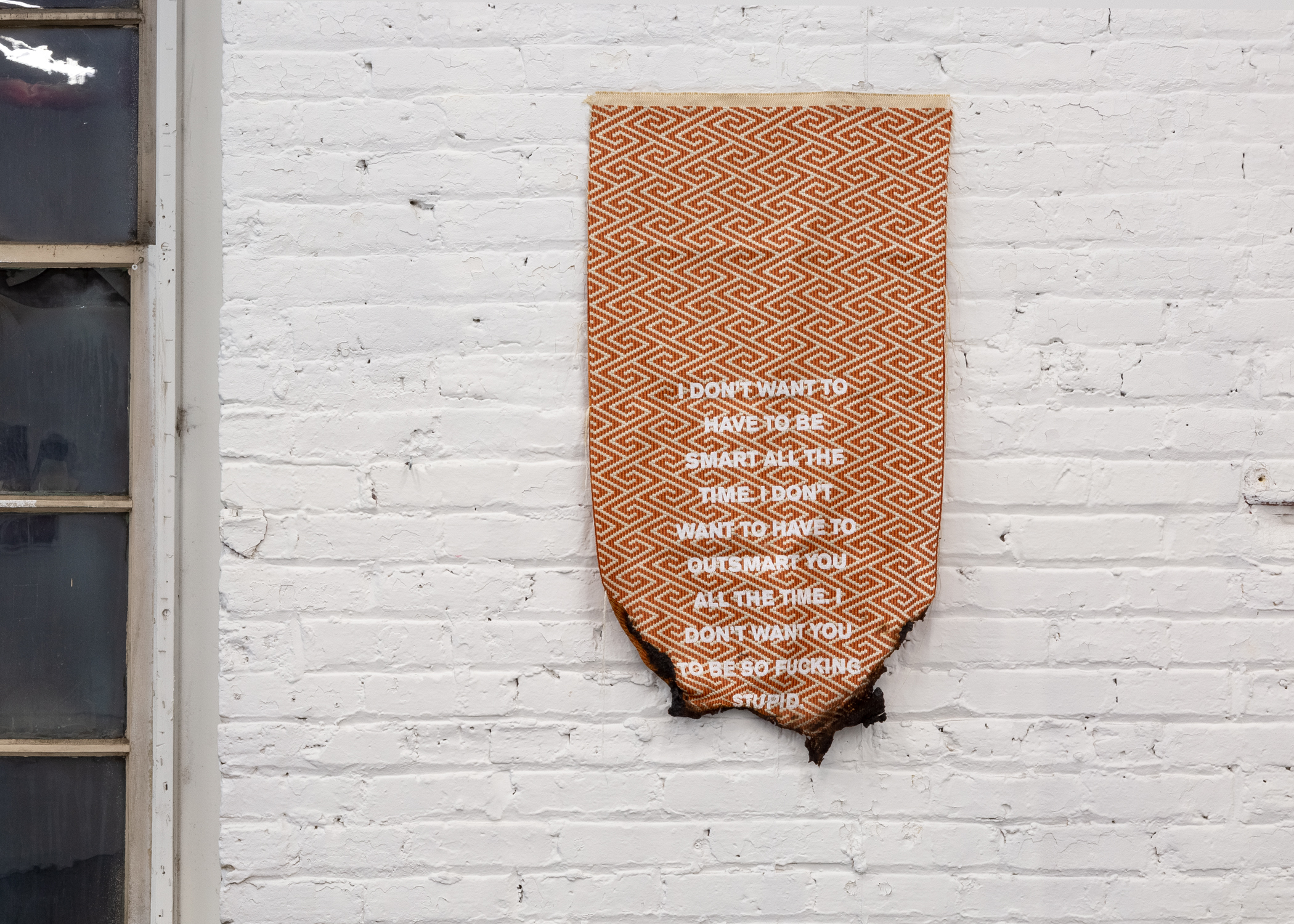
Image: Nick Drain “Black, American Flag #2”, Screen print on found fabric, 2019, 20 x 37 in. Text that reads “I don’t want to have to be smart all the time. I don’t want to have to outsmart you all the time. I don’t want you to be so fucking stupid.” is printed in white on a patterned orange fabric that hangs on the wall. The bottom of the fabric is partially burned at the edges. Photo by Randy Brown. Image courtesy of Genesis.
“In Plain Sight” also included a series of text-based “flags” that directly address the viewer with phrases like, “I don’t want to have to be smart all the time. I don’t want to have to outsmart you all the time. I don’t want you to be so fucking stupid” and “It’s always taking the high road” which are screen printed on fabric in a bold, striking font. Nick says, “A big reason why the flags are in the show is because, at certain points, images just aren’t direct enough, or they don’t come off the wall and hit you in the face. I need to shake certain viewers out of their bodies. I want to make work that requires work to understand”
The “you’s” and I’s” in the flag statements are confrontational to the viewer. One must determine if the statements are being spoken to them or for them and, in Nick’s words, “make a decision on where they stand.” The treatment of each flag surface carries a message on its own. For example, one is torn, one is burned, and one trampled on. There’s a clear relationship to David Hammons’ “African American Flag” which immediately came to mind during our conversation. Randy shares as we discuss the images and sculptures, “I find this collection really interesting because it’s really showing the full spectrum of how images work and how images function. There’s an obscuring of the traditional subject and there’s a power play happening, a reclamation of power, demanding the viewer put in work for the images to make sense.”
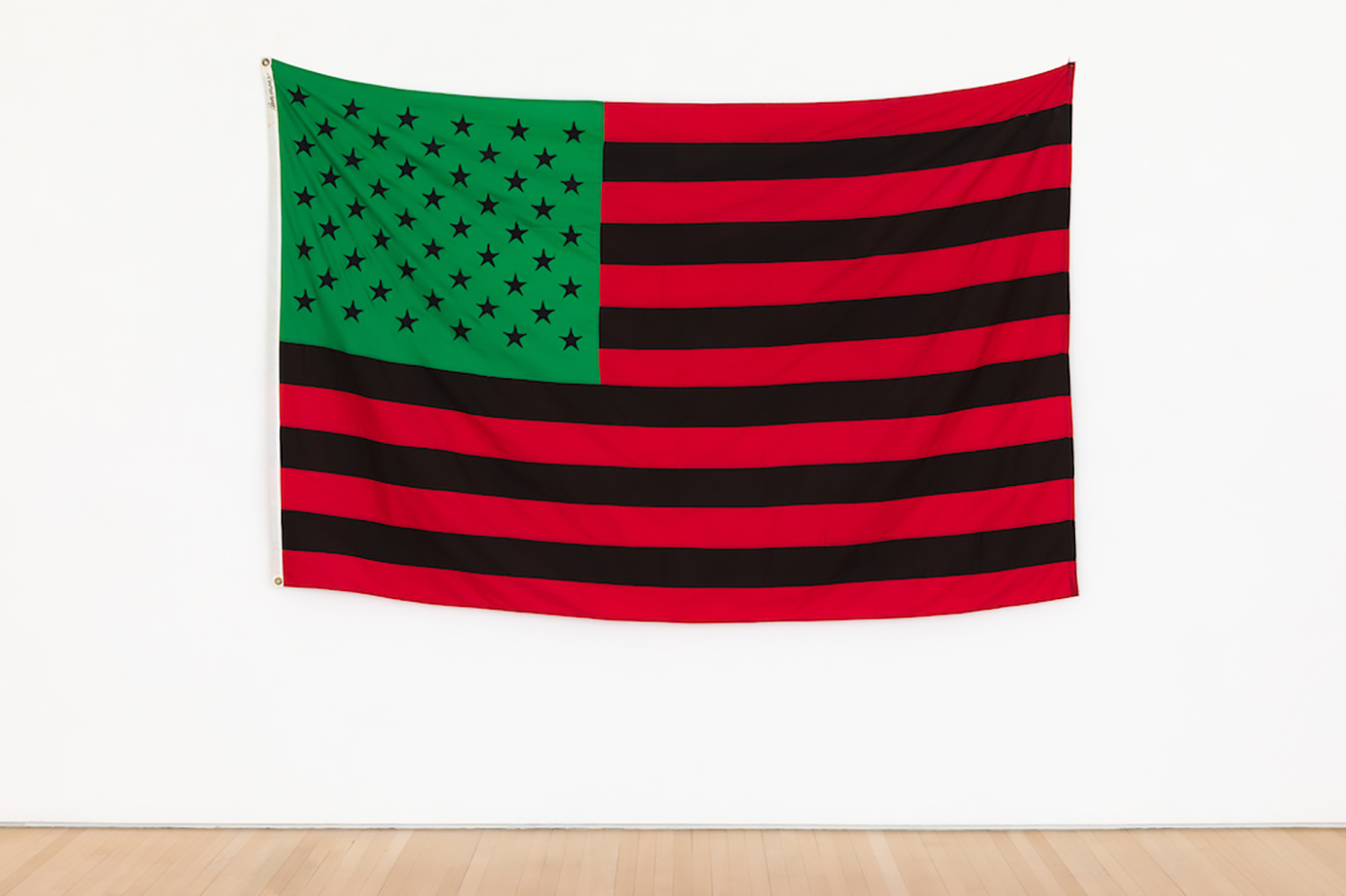
Image: David Hammons, “African-American Flag”, 1990, dyed cotton, 59 x 92 1/4 in. (149.86 x 234.315 cm). An interpretation of the American flag hangs on a white wall in the center of the photograph. The colors of the flag are red, green and black (as seen in the Pan-African flag) instead of red, white, and blue. Image courtesy of The Broad Foundation.
As Americans, we are expected to identify with this symbol of our country, but what happens when we don’t? Nick’s inspiration for his flags are an attempt to answer the question, “What does my flag look like?” Viewers of the exhibition are left wondering, “Is this flag accusing me?” “Is this statement directed towards me? Why? Am I the ‘you’?” Situated within the context of the rest of Nick’s exhibition, they carry a distinct and loud presence in the space. It certainly brings another level of connection to the collective Black experience. “[The flags] feel more like portraits because of the implication of a body through the absence of the body. They’re like vessels,” shares Randy.
Equally as profound as Nick’s work is the fact that it was presented at Genesis. In its first year, located in the heart of downtown Milwaukee, Randy worked with collaborators to program the space with community-focused projects and exhibitions. Following the recent move to Bayview, Randy took on curating and organizing exhibitions independently. He has established a clear vision and Randy shares that he “plans to exhibit even more work by BIPOC and LGBTQIA+ identifying artists, both emerging and established, that are actively engaging art history, while exploring new aesthetic practices.”
When discussing the importance of showing Nick’s work at the space, Randy said, “This show is part of a conversation that has been happening within art and within Black culture for a very long time, but it is also taking approaches that I do not currently see from other artists of color in Milwaukee. There are artists making work about their Black experience, but seldom few are making work that’s treating the black experience collectively as its own subject.”
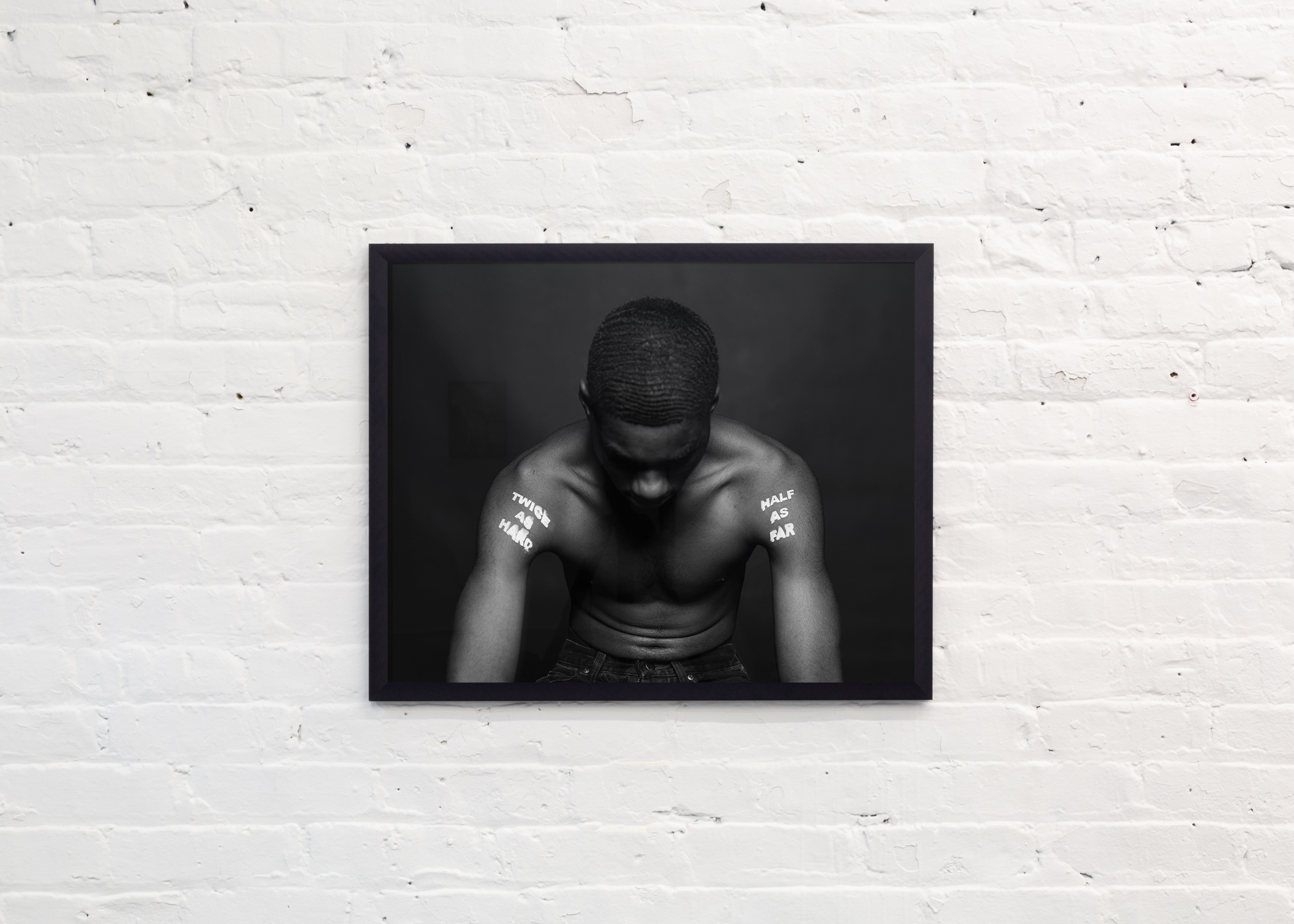
Image: Nick Drain “Twice as Hard”, Archival Inkjet Print, 2019, 20 x 25 in. A framed black and white photograph hangs on the wall. A black male figure sits shirtless facing the camera with his head hanging down. On his shoulders reads the text “Twice as hard, half as far”. Photo by Randy Brown. Image courtesy of Genesis.
In the same way that Nick pushes the function of images and the idea that Blackness cannot be contained within a singular image, but instead found living in the spaces between; Randy continues to challenge the function of a gallery space. Genesis exists to serve artists, to disrupt the status quo of white-owned and operated commercial gallery spaces in Milwaukee, and to give audiences something to discuss and take with them. He employs additional programming for nearly every exhibition engaging the community in ways beyond a traditional exhibition opening. For “In Plain Sight” Genesis held a panel talk and discussion on the camera, representation, and subjectivity titled “Do You See Me? How Do You See Me? What Do You See When You Look At Me?” with Nick Drain and artists Zora J Murff, Lois Bielefeld, and Sasha Phyars-Burgess. As well as a live art performance by Teena Wilder titled “Things I Took From My Father” which explored blackness, masculinity, and stillness.
The significance of “In Plain Sight” at Genesis requires a deeper level of thought, exploration, and questioning in order to acknowledge the presence of Blackness in our culture, our artwork, our galleries, in images, and in our city. Nick Drain is currently working to complete his thesis exhibition amidst the COVID-19 crisis and is just one of many students being affected by the mandatory closures that many schools around the nation are facing. Nick has been named a finalist for the Milwaukee-based emerging artist grant program The Grilled Cheese Grant, which raises funds specifically for artists who are working towards completing their thesis projects.
It’s clear that Genesis is making and creating space for artists in Milwaukee that both need and deserve to be heard; and I don’t see that ending anytime soon. So, Milwaukee, listen up.
Featured image: Nick Drain “One for Us” Archival Inkjet Print, 2019, Dimension Variable. Nine black male figures performing various activities fill the frame of the photograph. In the foreground, one figure is reading a book and in the middle two are playing a game. In the background against a photo backdrop with various props, a figure sits on a milk crate, another stands with his hands together looking down, and a group of four figures are dancing and smiling. Image Courtesy of the artist.
 Rachel Hausmann Schall is a visual artist, writer and educator living and working near Milwaukee, WI. She received her BFA in Integrated Studio Arts from the Milwaukee Institute of Art & Design in 2015 and became co-founder and co-director of the artist collective After School Special (2015-2019). She exhibits work at many galleries and alternative spaces in Milwaukee including Chamber, Frank Juarez Gallery, Usable Space, HOAX Gallery, and Var Gallery, among others. Her work explores the various forms of language and takes shape primarily as collage, painting and installation. She has shown her work nationally at many artist run spaces including Project 1612, Little Berlin and Lease Agreement for the Terrain Biennial 2019. She completed an artist residency at the Vermont Studio Center in Johnson, VT in 2019. Rachel Hausmann Schall is interested in artist-run, DIY, and alternative spaces that support emerging and underrepresented artists through exhibitions and programming within the greater Milwaukee area. Rachel Hausmann Schall is also a contributing writer for the Wisconsin based arts publication ArtDose Magazine and is co-organizer of the emerging artist grant and exhibition program The Grilled Cheese Grant. She works as a visual arts educator at Pius XI High School in Milwaukee, WI. Find more of her work at rhausmannschall.com.
Rachel Hausmann Schall is a visual artist, writer and educator living and working near Milwaukee, WI. She received her BFA in Integrated Studio Arts from the Milwaukee Institute of Art & Design in 2015 and became co-founder and co-director of the artist collective After School Special (2015-2019). She exhibits work at many galleries and alternative spaces in Milwaukee including Chamber, Frank Juarez Gallery, Usable Space, HOAX Gallery, and Var Gallery, among others. Her work explores the various forms of language and takes shape primarily as collage, painting and installation. She has shown her work nationally at many artist run spaces including Project 1612, Little Berlin and Lease Agreement for the Terrain Biennial 2019. She completed an artist residency at the Vermont Studio Center in Johnson, VT in 2019. Rachel Hausmann Schall is interested in artist-run, DIY, and alternative spaces that support emerging and underrepresented artists through exhibitions and programming within the greater Milwaukee area. Rachel Hausmann Schall is also a contributing writer for the Wisconsin based arts publication ArtDose Magazine and is co-organizer of the emerging artist grant and exhibition program The Grilled Cheese Grant. She works as a visual arts educator at Pius XI High School in Milwaukee, WI. Find more of her work at rhausmannschall.com.
